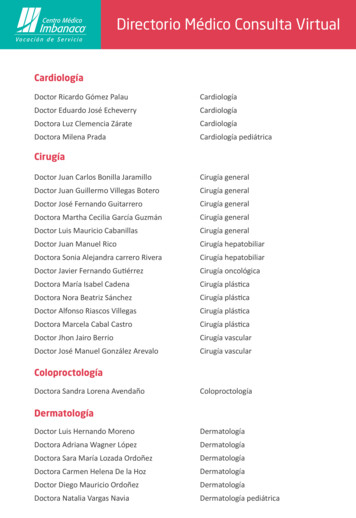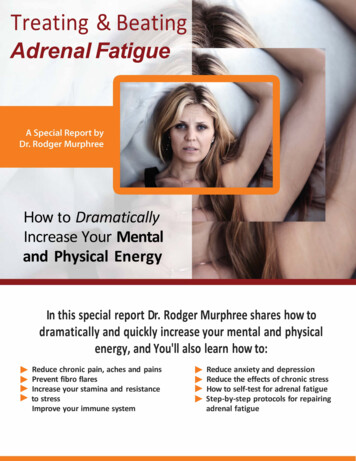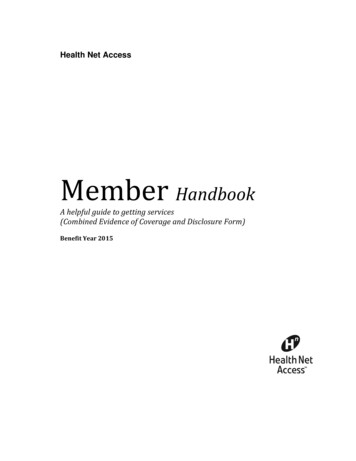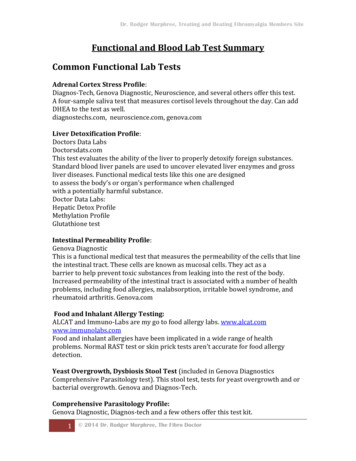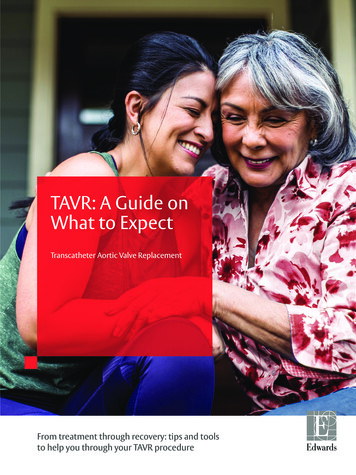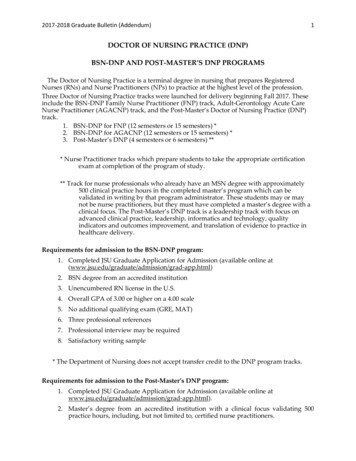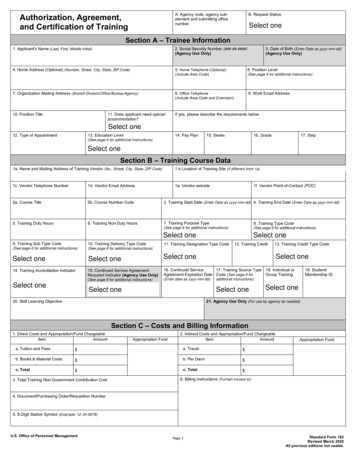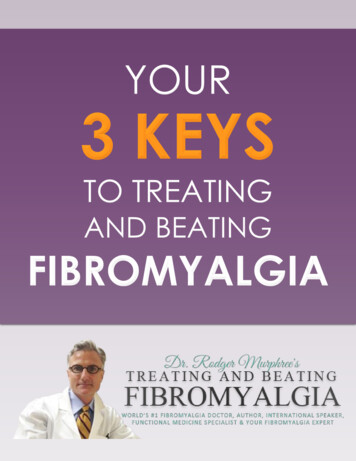
Transcription
ForewordDear Friend,After specializing in treating fibromyalgia for almost two decades,I’ve learned that there are several things you must do to have theopportunity to beat fibromyalgia. In fact, there are five keys, fivethings that must be done in order to beat fibromyalgia. Do thesethree things and you’ll most likely beat your fibromyalgia symptomsand feel good again.I have provided the first 3 keys as a gift, simply for taking the rightsteps to feeling better.To your best health,YOUR 3 KEYS TO TREATING AND BEATING FIBROMYALGIA1
Table of ContentsForeword . 1The First Key: Get Deep Restorative Sleep On a Consistent Basis . 3The Importance of a Good Night’s Sleep . 3Some Sleep Drugs Don’t Promote Deep, Restorative Sleep . 7The Second Key: Restore Optimal Adrenal Function . 14The Adrenal Gland . 16The Cortex . 17Adrenal Burnout . 18DHEA and Immune Function. 19Testing for Adrenal Fatigue . 20Basic Adrenal Fatigue Protocol . 21Vitamin C Dosing . 22The Third Key: Fix The Other Underlying Causes . 25YOUR 3 KEYS TO TREATING AND BEATING FIBROMYALGIA2
THE FIRST KEY:GET DEEP RESTORATIVE SLEEPON A CONSISTENT BASISThe Importance of a Good Night’s SleepWe've all heard that we need eight hours of restful sleep each night. Theamount of sleep an individual actually needs will vary from person toperson. A five-year-old may need eleven to twelve hours of sleep, an adultseven to nine hours of sleep a night. But why is a good night’s sleep soimportant? Several studies have shown that a lack of sufficient sleep willcause a host of unwanted health issues. Poor sleep has been linked tovarious health problems, including depression, poor immune function,anxiety, weight gain, muscle pain, low thyroid, irritable bowel syndrome,fatigue, CFS, fibromyalgia, and headaches. This isn’t news to those whosuffer with fibromyalgia and chronic fatigue syndrome; they already knowtheir symptoms get worse when they don’t get a good night’s sleep.YOUR 3 KEYS TO TREATING AND BEATING FIBROMYALGIA3
If you don’t get a good night’s sleep, you’re not going to feel well. It reallyis that simple. Most people with chronic illnesses, including those withfibromyalgia, haven’t slept well in years. Many of my patients take sleepingpills (tranquilizers), muscle relaxants, or over-the-counter sleep drugs to getthem to sleep. But most of these drugs don’t produce deep restorativesleep. Most folks taking these drugs don’t feel refreshed the next day.In fact, most users of these drugs report that they often feel hung over fromthese medications. And, as we’ll see later in this report, these drugs have sideeffects that can cause the very same symptoms associated with fibromyalgia;diffuse muscle aches and pain, depression, fatigue, and brain fog.One study showed that college students who were prevented from goinginto deep (REM) sleep for a week developed the same symptomsassociated with FMS and CFS: diffuse pain, fatigue, brain fog, irritable bowelsyndrome, lowered immune function, depression, anxiety, irritability,stomach disturbances, and headache. Another study, conducted by theUniversity of Connecticut School of Medicine, compared the sleep patternsand associated symptoms of fifty women with FMS. The study showed thata poor night’s sleep was followed by an increase in the subject’s symptoms,especially body pain. Sadly, the study also showed that a poor night’ssleep, followed by an increase in symptoms, then went on to prevent theperson from getting a good night’s sleep the next night, even though thesubject was exhausted. This vicious cycle continues and creates a patternof declining health.And research presented at the Endocrine Society in San Francisco, in June2002, showed that sleep deprivation markedly increased inflammatorycytokines (pain causing chemicals)—by a whopping 40 percent. SleepCycles Sleep cycles follow our circadian rhythms. It has been found that thenatural hormone melatonin plays a large part in mediating sleep. Asdarkness falls, enzymes in the brain stimulate the release of melatonin fromthe pineal gland in the brain. Melatonin induces sleep, and then the releaseof melatonin is halted when daylight arrives and we experiencewakefulness. Upon falling asleep, the brain and body go through five stagesYOUR 3 KEYS TO TREATING AND BEATING FIBROMYALGIA4
of sleep in one sleep cycle. Researchers have classified these stages ofsleep by monitoring muscle tone, eye movements, and the electricalactivity of the brain using an electroencephalogram (EEG). EEG readingsmeasure brain waves and classify them according to speed. Alpha rhythmsare the fastest waves, followed by slower beta rhythms. Theta and deltawaves are the slowest. A sleep cycle lasts 90 minutes or so, during which thebrain revolves through each type of EEG rhythm. This sleep cycle isrepeated approximately five or six times during the course of the night andcorresponds to the circadian rhythms, which we experience during theday.The first four stages are considered to be Non-Rapid Eye Movement sleep(NREM) or orthodox sleep. The function of these stages is to restore andrebuild the body after a long period of wakefulness. Vegetative functionsdominate NREM sleep. The body temperature, heart rate, and bloodpressure decrease, muscles relax, and the body metabolism slows. Stage Iis a transition between sleep and wake-fullness, which is usually only fiveminutes in duration. Short dreams may occur, usually involving imagesYOUR 3 KEYS TO TREATING AND BEATING FIBROMYALGIA5
remembered from throughout the day. Stage II is a somewhat deeper levelof sleep, characterized by slower breathing and heart rates. About fiftypercent of all sleep in a given night is Stage II. Stages III and IV are thedeepest levels of sleep and have the slowest waves, as measured by EEG.Stage III has both theta and delta rhythms, while Stage IV has only deltarhythms. The body uses this time to maintain and restore itself. Growthhormone secretions are at their highestduring these stages. Stages III and IVbegin after one has been asleep forapproximately one-half hour. This is thedeep, restorative sleep that we all needin order to be healthy. Stage V isremarkably different from the previousstages. The brain and body becomeactive, increasing heart rate and bloodpressure. The eyes shudder quickly backand forth, giving this stage the nameRapid Eye Movement (REM) sleep. EEGpatterns for REM sleep are much likethose during wakefulness, and includemany fast beta rhythms. It may even bethat the brain works harder during REMsleep than when awake.REM sleep usually lasts anywhere from 11 to 25 minutes, typically longer inthe later sleep cycles of the night. Approximately 25 percent of all sleep isREM sleep in adults; in children, it is even higher (up to 50 percent). Oncompletion of a phase of REM sleep, the brain and body return to Stage Iand begin another sleep cycle. The differences between NREM and REMsleep are dramatic. As mentioned above, NREM sleep deals mainly withthe regeneration of the body, especially Stages III and IV, while REM sleephas much to do with the inner-workings of the brain. Researchers havespeculated that NREM sleep (especially Stages III and IV) also functions torecharge the brain and body by allowing depleted glycogen supplies tobe replenished.YOUR 3 KEYS TO TREATING AND BEATING FIBROMYALGIA6
Some Sleep Drugs Don’t Promote Deep,Restorative SleepPlease note that many of the current recommended sleeping pills DON’Tproduce deep Stage III and IV restorative sleep. Most of the sleep drugs,especially the sedatives (tranquilizers), don't allow a person to go into deep(Stage III and IV) restorative sleep. So they have their eyes closed whilethey're knocked out for eight hours, but they don't receive the healthbenefits of deep, restorative sleep. They often feel hung over in the morningand have to rely on stimulantdrugs or beverages to getthem going. This cycle oftenfurther interferes with theirsleep/wake cycle, especially ifthey consume caffeinatedbeverages throughout theday. In fact, many of thesesleep drugs actually depletethe body’s own natural sleephormone, melatonin.Warning: Your Sleep Drug May Be Doing More Harm Than Good. Sleepmedications can cause numerous side effects. Each year Americansconsume five billion sleeping pills and sadly, 15,000 Americans die fromtaking sleeping pills.Prescription drugs that may be used for sleep disorders include thefollowing: Ambien (zolpidem) is a short-acting drug that usually lasts for fourto six hours. If a patient takes a half-dose before bed, then he can take anadditional half-dose if needed four to six hours later. Even though theliterature on Ambien suggests patients don't build up a tolerance, many do.Some patient's do well on Ambien; some build up a tolerance over a periodof time and need higher and higher doses until finally the medicine nolonger works. It does promote deep, restorative sleep.YOUR 3 KEYS TO TREATING AND BEATING FIBROMYALGIA7
However, the side effects are similar tofibromyalgia and CFS. Side Effects: Short-termmemory loss, fuzzy thinking, sedation or nextday hangover, mood disorders (anxiety anddepression), flu-like symptoms, muscle achesand pains, and in-coordination (clumsy).Ambien may cause fatigue, headache,difficulty sleeping, and memory loss. Longterm use (two weeks or more) can result inconstipation, upset stomach, joint pain, upperrespiratory infections (URI), sore throat, urinaryinfection, and heart palpitations. The liverprocesses this drug, like most drugs, so thosewith sluggish liver function should use this medication with caution. The mostcommon side effects include dizziness and diarrhea. Some patientscomplain of loss of coordination or concentration. Ambien is known tocause amnesia (short-term memory loss). Patients are cautioned againstabruptly stopping the medicine, since withdrawal symptoms commonlyoccur.Lunesta (eszopiclone) is similar to Ambien. Side effects include thefollowing: Allergic reactions (itchy, watery eyes, rash, difficulty breathing,swelling of face, tongue, or throat), confusion, anxiety, depression,hallucinations (seeing, hearing, or feeling things that are not really there),lightheadedness, fainting spells, or falls, sleepwalking or performing otheractivities while asleep, slurred speech or difficulty with coordination, visionchanges, restlessness, excitability, or feelings of agitation, dizziness, daytimedrowsiness (sometimes called a 'hangover' effect), headache, strangedreams, bad taste, and slight stomach pain. It does promote deep,restorative sleep.But, once again, look at the potential side effects.Tricyclic Antidepressants Doxepin, Elavil, Trazadone, Amitriptyline,Despramine, Imipramine, Pamelor, etc. Tricyclic antidepressants block thehormones serotonin and norepinephrine. This produces a sedative effect.YOUR 3 KEYS TO TREATING AND BEATING FIBROMYALGIA8
These drugs do promote deep, restorative sleep. But, as you’ll read below,they are associated with numerous unwanted side effects. Like otherantidepressant medications, these drugs are processed by the liver andcan cause liver toxicity. These drugs deplete the natural sleep hormonemelatonin and CoQ10. Anyone taking tricyclic antidepressants, betablockers, and/or statin drugs should be taking CoQ10 on a daily basis. Thesedrugs deplete CoQ10. CoQ10 is vital for proper heart, brain, muscle, andliver function. Low levels of CoQ10 can cause a host of unwantedsymptoms, including fatigue,muscle pain, high bloodpressure,congestiveheartfailure, brain fog, tingling in thehands and feet, swelling, andmood disorders.They can cause early morninghangover. They do promotedeep, restorative sleep.Common side effects include upset stomach, constipation, bad taste in themouth, heartburn, diarrhea, rash, rapid heartbeat, mental confusion,hostility, swelling in the arms or legs, dizziness, nightmares, drowsiness, andfatigue.Zanaflex (tizanidine) is a muscle relaxant that has gained some popularityamong physicians treating FMS. It is sedating, but it doesn’t produce deep,restorative sleep. And it doesn’t help increase serotonin levels; it onlytranquilizes the nervous system. For this reason alone, it should be avoided.YOUR 3 KEYS TO TREATING AND BEATING FIBROMYALGIA9
Zanaflex is associated with numerous side effects, including liver failure(at least three individuals have died from taking this medication),asthenia (weakness), somnolence (prolonged drowsiness or a trancelike condition that may continue for a number of days), dizziness, UTI(urinary tract infection), constipation, liver injury, elevated liverenzymes, vomiting, speech disorder, blurred vision, nervousness,hypotension, psychosis / hallucinations, bradycardia (slow heartaction), pharyngitis (sore throat), and dyskinesia (defect in voluntarymovements).The stuff is poison!Sonata (zaleplon) is designed to last for only four hours; this helps preventmorning hangover. I’ve not found it to be very effective, though, since mostof my patients have trouble sleeping through the night, not just with gettingto sleep. Abdominal pain, amnesia, dizziness, drowsiness, eye pain,headache, memory loss, menstrual pain, nausea, sleepiness, tingling, andweakness.Lyrica, (pregabapentin) and Neurontin (gabapentin) are anticonvulsantmedications originally used to control seizures. They are now being used toblock nerve related pain (neuralgia), including pain caused by herpeszoster. These medications are also being prescribed for chronic headaches(with some success) and fibromyalgia (little success). I’ve not found themto be helpful for the diffuse extremity pains associated with fibromyalgia.They don’t promote deep, restorative sleep and can cause many of thesame symptoms associated with fibromyalgia, including fatigue, muscleaches, poor mental clarity (“fibro fog”), and mood disorders. Most patientscan wean off these medications with the help of their physician (slowly,within four weeks) with no problem.YOUR 3 KEYS TO TREATING AND BEATING FIBROMYALGIA10
There are several side effects associated with their use, includingsomnolence (prolonged drowsiness or a trance-like condition that maycontinue for a number of days), dizziness, weakness, fatigue, double vision,edema (fluid retention), ataxia (muscular incoordination), thought disorder,possible long-term ophthalmic problems (abnormal eyeball movementsand disorders), tremors, weight gain, back pain, constipation, muscleaches, memory loss, asthenia (weakness), depression, abnormal thinking,itching, involuntary muscle twitching, serious rash, and runny nose.Benzodiazepines or Anti-Anxiety Medications Xanax, Klonopin, Ativan,Restoril, Busbar, Tranxene, Serax, Librium,Tegretol, Valium, Trileptal,Seraquel, Risperdal, Symbax, etc. These medications are usually used asanti-anxiety medication. They’re addictive, and patients build up atolerance so that the drug eventually loses it effectiveness as a sleep aid.Sadly, patients often become addicted to these drugs within two to threeweeks. These medications are loaded with side effects that cause furtherhealth problems (depression, fatigue, memory loss, “fibro fog’” etc.), yetdon’t promote deep, restorativesleep. They actually deplete thenaturalsleephormonemelatonin. And, as you learnedabove, they deplete CoQ10.Benzodiazepines are centralnervous system depressants (thereason why depression andfatigue are common side effects)that act on the neurotransmitterGABA (gamma-amino butyricacid). GABA acts as a calming chemical as it transmits messages from onecell to another. Directly or indirectly, these drugs influence almost everybrain function and most other bodily systems, including the central nervous,neuromuscular, endocrine, and gastrointestinal systems. Benzodiazepineshave numerous side effects, including poor sleep, seizures, mania,depression, suicide, ringing in the ears, amnesia, dizziness, anxiety,disorientation, low blood pressure, nausea, fluid retention, sexualYOUR 3 KEYS TO TREATING AND BEATING FIBROMYALGIA11
dysfunction (decreased desire and performance), weakness, somnolence(prolonged drowsiness or a trance-like condition that may continue for anumber of days), headaches and tardive dyskinesia.A mind boggling 40 percent of adults who are 60 or older experience druginduced tics or tardive dyskinesia (tremors or uncontrollable shakes) fromtaking a benzodiazepine drug. Sadly, for many, these tremors are permanent.Over 61,000 older adults have developed Parkinson’s disease from usingantipsychotic drugs (benzodiazepines and antidepressants).The crippling side effects and addictive nature of these drugs has beenknown for at least 40 years, yet doctorscontinue to prescribe them at an everincreasing rate.Surveys show that over 5.6 millionadults over the age of 65 are nowtakingbenzodiazepines.Anincredible 50 percent of all women60 and older will be prescribed abenzodiazepine drug. And sinceaddiction often occurs within two tofour weeks of starting these drugs, themajority of folks are now dependent onthese drugs. Tolerance to the hypnotic(sleep) effects of these drugs may occur within one week. Symptoms oftolerance are identical to drug withdrawal symptoms and may includeanxiety, panic, severe insomnia, muscle pain and stiffness, depression,suicidal thoughts, rage, heart and lung problems, and agoraphobia(extreme fear of public or crowded spaces). Tragically, only 10 to 30percent are able to successfully stop taking these drugs. Most are addictedfor life.These drugs can severely impair mental clarity, especially in the elderly. Ina study in the state of Washington, in 46 percent of the patients with drug-YOUR 3 KEYS TO TREATING AND BEATING FIBROMYALGIA12
induced mental impairment, the problem was caused by minor tranquilizersor sleeping pills (benzodiazepines, Ambien or Lunesta.); and in 11 percent,by antipsychotic drugs (antidepressants). How many of these folks are thenerroneously diagnosed as having senile dementia, Alzheimer’s, or worse?Please understand these drugs don’t promote deep, restorative sleep andactually deplete the natural sleep hormone melatonin. Melatonin is thesleep hormone! It can be purchased at most health food and pharmacystores and works for the first night for the majority of those who take it. Justas important, it doesn’t have all the side effects associated with prescriptionsleep drugs. Studies show that declining levels of the sleep hormonemelatonin is the cause of their poor sleep. As we age, our melatonin levelsbegin to drop. Older adults have one-third to one-quarter the amount ofmelatonin as younger adults. Ok, so I’ve warned you about the potentialdangers of common sleep drugs. You should now know that you don’tneed to rely on potentially dangerous drugs. No one has a drug deficiency.Fortunately, there is a better way to consistently get a good night’s sleep.Instead of using potentially dangerous life robbing drugs, my patients findthat by using the right combination of vitamins, minerals, amino acids,diet, and neutracuticals, they are able to fall asleep and sleep throughthe night.YOUR 3 KEYS TO TREATING AND BEATING FIBROMYALGIA13
THE SECOND KEY:RESTORE OPTIMALADRENAL FUNCTIONMost of my patients have notonly bankrupted their bankaccounts,but,havealsobankrupted their stress copingglands, their adrenal glands. Thisis known as adrenal fatigue. Thesymptoms we see with adrenalfatigue are many of the samesymptomsweseeinfibromyalgia.Poorsleep,fatigue, low moods, anxiety,depression,weightgain,headaches, cold hands, coldfeet, tingling and numbness inthe hands and feet, fibro fog,and chronic pain. What theyfind, is they no longer have theirresistance and stamina to stress.The adrenals are a pair of peasized glands located atop eachkidney. The adrenal gland consists of two sections: the medulla (innerportion) and the cortex (outer portion). The adrenal glands release certainhormones that allow us to be able to deal with immediate and long-termstress. These glands and the hormones they release allow us to be resilientto day-to-day stress.YOUR 3 KEYS TO TREATING AND BEATING FIBROMYALGIA14
Under-active adrenal glands are evident in about two-thirds of fibropatients. The majority of my patients with fibromyalgia are suffering fromadrenal fatigue. They have literally burned their stress-coping organs out.Amid years of poor sleep, unrelenting fatigue, chronic pain, excessivestimulants, poor diet, and relying on a plethora of prescription medications,the adrenal glands and the hormones they release have been used up.Once adrenal exhaustion sets in, it’s not long before the body begins tobreak down. Getting “stressed out” and staying “stressed out” is thebeginning of chronic illness including fibromyalgia.So after establishing deep restorative sleep, you have to also correct thisadrenal fatigue issue so you don’t see the ups and downs of Fibromyalgia you know one day is a good day or a bad day. And of course you neverknow, so you can’t make any plans because you don’t know if it is goingto be a good day or a bad day.Stress becomes magnified.Changes in the weather, traffic jams,loud noises, bright lights, and otherstressors that used to be tolerated nowcan be debilitating. The longer you havethe Fibromyalgia, the more likely you areto see that any kind of stimulation can beoverwhelming. To the point, that manypeople withdraw further and further fromlife. Some become a recluse finding it too stressful to even leave the house.For many, it’s herculean task to get up, get dressed, put on their makeupand even think about going grocery shopping much less going to work,entertaining, traveling, spending time with friends or participating in any lifepleasures. You find that if you do have a rare day or two where you feelrested because maybe you have gotten a good night sleep, if you over doit, which can something as simple as going to am movie with friends orfamily, you crash for the next two days.YOUR 3 KEYS TO TREATING AND BEATING FIBROMYALGIA15
The Adrenal GlandThe MedullaIn the inner region of each adrenal gland is what’s known as the medulla.The adrenal medulla produces norepinephrine and epinephrine(adrenaline). These hormones are known as catecholamines. The medullahormones are primarily involved in acute (immediate) responses to stress.Epinephrineincreases the speedand force of theheartbeat.increases systolic bloodpressure (the topnumber -120/80)increases pulse rateincreases cardiac(heart) functiondilates (opens) theairways to improvebreathingincreases the rate anddepth of respiration toallow more oxygen toreach the bloodstreammobilizes sugar fromthe liver to the bloodstream in preparationof the fight or flightresponseregulates circulatory,nervous, muscular, andrespiratory systemswhen needed.inhibits the muscle toneof the stomach, so youmay feel a “knot” inyour stomach duringtimes of stress.Restoring adequate epinephrine levels is important. This can be done withSAMe However, I’ve found that by restoring the adrenal cortex and itshormones, cortisol and DHEA, adrenal fatigue can be overcome.YOUR 3 KEYS TO TREATING AND BEATING FIBROMYALGIA16
The CortexThe adrenal cortex is primarily associated with response to chronic stress(infections, prolonged exertion, prolonged mental, emotional, chemical, orphysical stress). The hormones of the cortex are steroids. The main steroid iscortisol.Chronic over secretion of cortisol leads to adrenal exhaustion, whichaccelerates the downward spiral towards chronic poor health. Once inadrenal exhaustion your body can’t release enough cortisol to keep upwith the daily demands. Eventually you become deficient in cortisol andthen DHEA.Chronic headaches, nausea, allergies, nagging injuries, fatigue, dizziness,hypotension, low body temperature, depression, low sex drive, chronicinfections, and cold hands and feet are just some of the symptoms thatoccur with adrenal cortex exhaustion.Abnormal Circadian RhythmCortisol levels are affected by stress and the body’s circadian rhythm(sleep-wake cycle). Cortisol secretions rise sharply in the morning, peakingat approximately 8 a.m. After its peak, cortisol production starts to taper offuntil it reaches a low point at 1 a.m.Fluctuations in cortisol levelscan occur whenever normalcircadian rhythm is altered (achange in sleep-wake times).Traveling through different timezones (jet lag), changes in workshifts, or a change bed timecan cause drastically alternormal cortisol patterns. Somepatients will report that theirsymptoms began when they began working at night. Some will begin tohave symptoms after staying up several nights in a row to take care ofYOUR 3 KEYS TO TREATING AND BEATING FIBROMYALGIA17
invalid family members or newborn babies. Changes in circadian rhythmcan lead to insomnia and poor sleep. An example of this occurs when aperson tries to go to sleep at a certain time but can’t wind down. They maycatch a second wind when their cortisol levels kick-in. This is why it isimportant for you to try to go to bed (preferably before 11:00 p.m.) andwake-up at the same time each day. Establishing normal sleep and waketimes is crucial in restoring normal circadian rhythms.Adrenal BurnoutPeople often experience stress reactions every few minutes whenbombarded by stimulus coming from our radios, driving in traffic, cellphones, pagers, and from electromagnetic pollution.Persistent, unrelenting stress will ultimately lead to adrenal burnout.The adrenal cortex, when healthy, produces adequate levels ofdehydroepiandrosterone (DHEA).DHEA boosts: energy sex drive resistance to stress self-defense mechanisms (immune system) general well-beingand helps toraise: cortisol levels overall adrenal function mood cellular energy mental acuity muscle strength staminaYOUR 3 KEYS TO TREATING AND BEATING FIBROMYALGIA18
DHEA is notoriously low in fibromyalgia patients. Chronic stress initiallycauses the adrenals to release extra cortisol. Continuous stress raises cortisolto abnormally high levels. Then the adrenal glands get to where they can’tkeep up with the demand for more cortisol. As the cortisol levels continueto become depleted fromongoing stress the bodyattempts to counter this byreleasingmoreDHEA.Eventually they can’t produceenough cortisol or DHEA.Aging makes holding on toDHEA even tougher. Even inhealthyindividuals,DHEAlevels begin to drop after theage of 30. By age 70, they areat about 20% of their peak levels. Stress and DHEADHEA helps prevent thedestruction of tryptophan (5HTP), which increases the production ofserotonin. This helps provide added protection from chronic stress. Studiescontinue to show low DHEA to be a biological indicator of stress, aging, andage-related diseases including neurosis, depression, peptic ulcer, IBS, andothers.DHEA and Immune FunctionThe decrease in DHEA levels correlates with the general decline of cellmediated immunity and increased incidence of cancer. DHEA protects thethymus gland, a major player in immune function.Billie Jay Sahley, PhD, writes, “over secretions of the stress hormones[cortisone, cortisol, and corticosterone], caused by long-term mental orphysical effort, could lead to cancer, arthritis, and susceptibility toinfections. Many psychosomatic disorders are transmitted from the brain tothe skeletal muscle system. Anxiety, stress, anger, or any other psychic statecan greatly change the amount of nervous stimulation to the skeletalYOUR 3 KEYS TO TREATING AND BEATING FIBROMYALGIA19
muscles throughout the body, and either increase or decrease the skeletalmuscular tension.”These same stimulatory responses that affect the muscles also causechanges in various bodily organs: abnormal heartbeats, peptic ulcers (toomuch stomach acid), hypertension, spastic colon, and irregular menstrualperiods. This is why you can’t separate emotional stress from physical stress.Testing for DHEA levels is recommended.Testing for Adrenal FatigueAdrenal cortisol levels can be uncovered through blood and saliva testing.Saliva is preferred since it is easier to get four samples throughout the day.Self-Test MethodsA quick blood pressure test that monitorslying and standing systolic numbers canhelp us begin a trial treatment ofadrenal boosting supplements.Orthostatic Blood PressureRagland’s sign is an abnormal drop insystolic blood pressure (the top number)when a person arises from a lying to astanding position. There should be a riseof 8–10 mm. in the systolic (top) number.A drop or failure to rise, indicatesadrenal fatigue.Example: Someone takes your blood pressure while you’re lying on yourback. The systolic number is 120 and the diastolic number is 60 (120 over60). Then take your blood pressure again after immediately standing up.The systolic number (120) should go up 10 points (from 120 to 130). If itdoesn’t increase 10 points, this indicates adrenal fatigue.YOUR 3 KEYS TO TREATING AND BEATING FIBROMYALGIA20
Note: It’s not unusual for the systolic number to drop 10 or more points, asure sign of adrenal fatigue.Pupil Dilation TestAnother way to test for adrenaldysfunction is the pupil dilationexam. To perform this onyoursel
YOUR 3 KEYS TO TREATING AND BEATING FIBROMYALGIA 8 However, the side effects are similar to fibromyalgia and CFS. Side Effects: Short-term memory loss, fuzzy thinking, sedation or next-day hangover, mood disorders (anxiety and depression), flu-like symptoms, muscle aches and pains, and in-coordination (clumsy).
